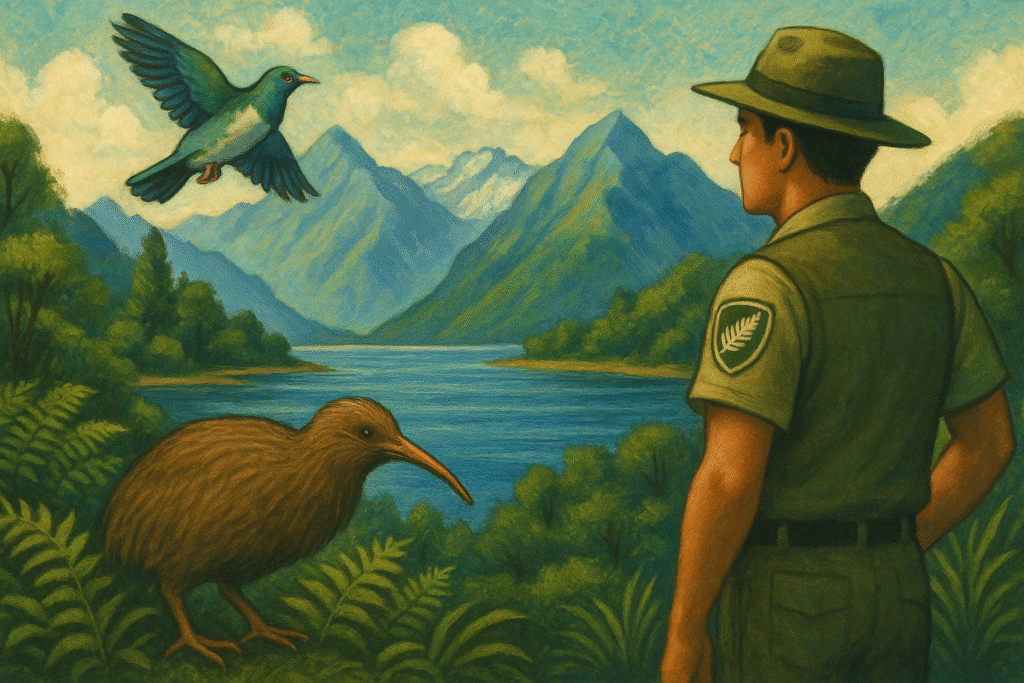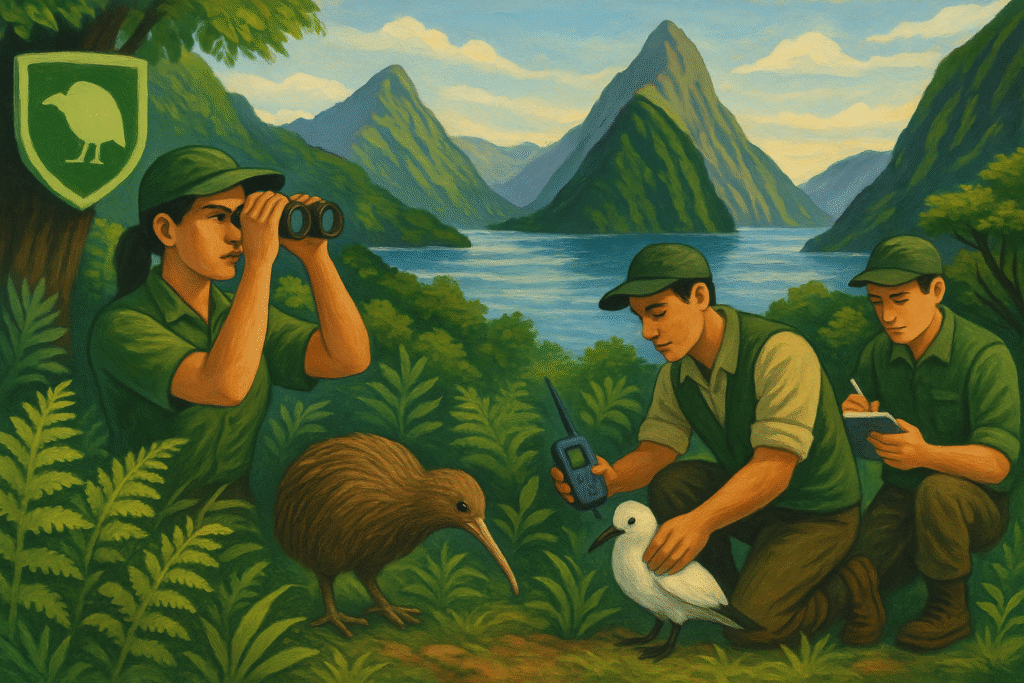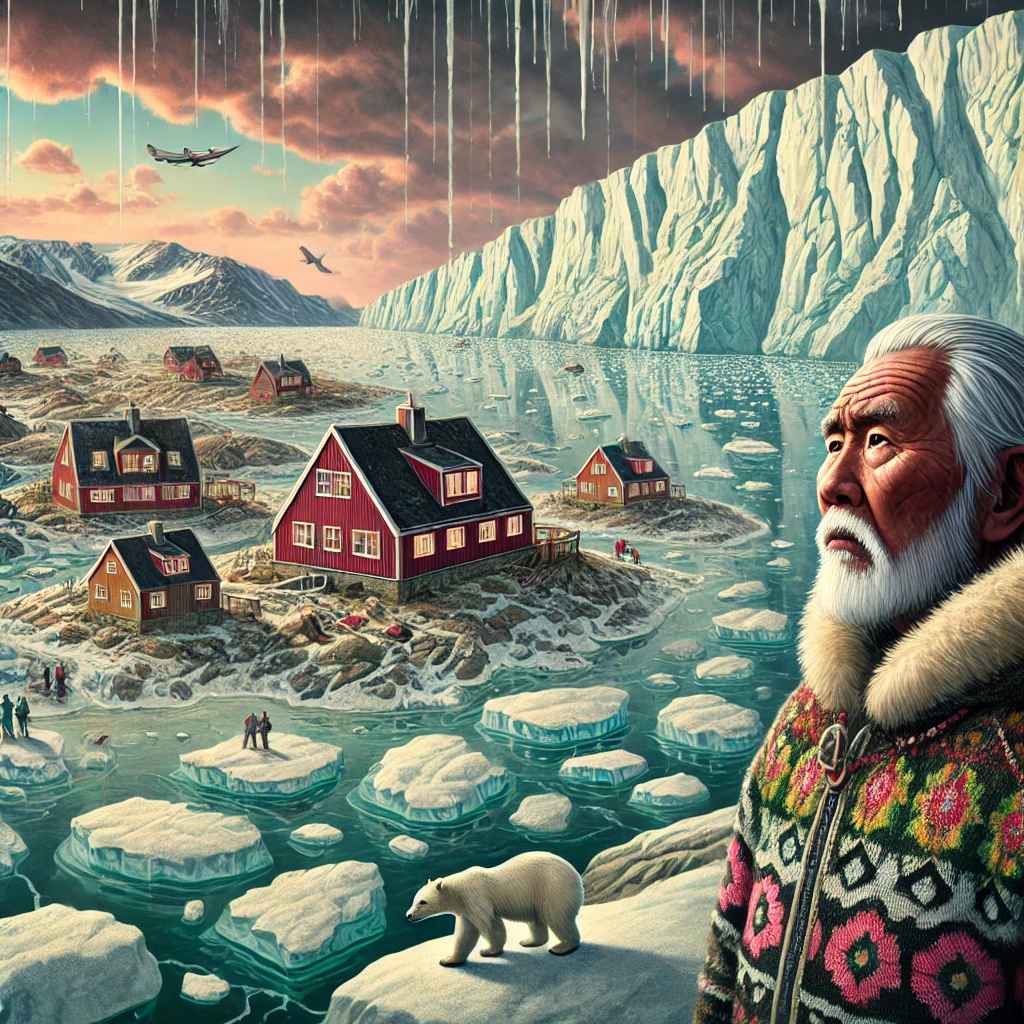Table of Contents
Introduction to New Zealand’s Natural Heritage
New Zealand, an archipelago located in the southwestern Pacific Ocean, is renowned for its stunning natural heritage characterized by a vast array of ecosystems and breathtaking landscapes. The country’s natural heritage encompasses the unique flora and fauna, geological formations, and diverse climates that collectively contribute to its rich biological diversity. This natural wealth not only plays a crucial role in sustaining wildlife but also significantly influences the cultural identity of the local communities.
Defining natural heritage involves recognizing the interconnectedness of ecosystems, species, and their habitats, which are often shaped by geological processes and climatic conditions over millions of years. In New Zealand, the isolation of its landmass has resulted in a high level of endemism, meaning many species found here are not seen anywhere else on the planet. From the subtropical forests of the North Island to the alpine landscapes of the South Island, the variability in ecosystems offers a sanctuary for a multitude of species, making the preservation of this natural heritage vital for maintaining biodiversity.
Moreover, New Zealand’s natural environment holds deep cultural significance for the Māori people, who have long recognized their connection to the land, water, and wildlife. Their traditions and beliefs are closely tied to the preservation of natural elements, which are viewed as vital components of their identity and heritage. As such, the safeguarding of these natural resources is not only important for ecological balance but also for maintaining the historical and cultural narratives of the region.
In addition to its ecological and cultural importance, New Zealand’s natural heritage plays a pivotal role in promoting eco-tourism. The country’s diverse landscapes attract millions of visitors each year, fostering a deeper appreciation for its unique environment and highlighting the need for sustainable practices aimed at conservation. Protecting this stunning natural heritage thus becomes essential not only for current generations but also for the future, ensuring the continuity of both biodiversity and cultural legacies.

National Parks and Reserves: The Backbone of Conservation
New Zealand’s commitment to conservation is exemplified through its extensive network of national parks and reserves, which play a pivotal role in preserving the country’s unique natural heritage. These protected areas, covering approximately 30 percent of New Zealand’s landmass, undergo meticulous planning and management to ensure that they maintain the ecological integrity of their diverse environments. The establishment of national parks, beginning with Tongariro National Park in 1887, paved the way for a robust conservation framework that prioritizes the safeguarding of native flora and fauna.
The creation of national parks and reserves is not merely a matter of land designation; it involves a comprehensive approach that considers the ecological significance of the landscapes and the species that inhabit them. Each park is managed by the Department of Conservation (DOC), which employs a team of ecologists and conservation experts dedicated to protecting the biodiversity within these areas. This includes specific initiatives aimed at controlling invasive species, restoring habitats, and fostering the recovery of endangered species such as the kiwi and the Hector’s dolphin, both iconic to New Zealand.
In addition to their ecological importance, national parks and reserves also offer invaluable recreational opportunities for both residents and visitors. They serve as venues for a wide range of outdoor activities, including hiking, birdwatching, and camping, allowing people to connect with nature while fostering a greater appreciation for the environment. Facilities and infrastructure within these parks are designed to enhance the visitor experience while ensuring minimal impact on the surrounding ecosystems. As international tourists flock to these pristine landscapes, the parks contribute significantly to New Zealand’s economy, showcasing its commitment to balancing conservation with sustainable tourism.
Ultimately, New Zealand’s national parks and reserves stand as a testament to the country’s dedication to conserving its vivid natural beauty and rich biodiversity, making them essential components of the nation’s environmental strategy.
Legislation and Policy Framework for Environmental Protection
New Zealand has established a robust legislative and policy framework aimed at safeguarding its unique natural heritage. Central to this framework is the Resource Management Act 1991 (RMA), which serves as a comprehensive statute governing land use planning and environmental management. This act is pivotal as it promotes sustainable management of natural and physical resources, ensuring that the use of land, water, and air meets the needs of current generations without compromising future generations’ ability to meet their own needs. The RMA mandates the consideration of environmental impacts during the planning stages of development, thereby reinforcing New Zealand’s commitment to environmental conservation.
Complementing the RMA is the New Zealand Biodiversity Strategy, an essential policy document aimed at protecting the rich biodiversity that characterizes the country. The strategy sets out a framework for coordinated efforts across various sectors to halt the decline of native species and ecosystems. This strategy emphasizes the importance of integrated management approaches, engaging multiple stakeholders including iwi (Māori communities), local governments, and conservation agencies. By fostering collaboration, the strategy seeks to enhance participation and shared ownership in biodiversity conservation.
Additionally, the Conservation Act 1987 governs the management of protected areas, ensuring that national parks and reserves prioritize ecosystem protection and enhance public enjoyment of these natural spaces. The act reflects New Zealand’s ethos of preserving its natural landscapes while also recognizing the importance of recreation and tourism. Other legislation, including the Environmental Protection Authority Act, plays a vital role by overseeing the environmental impact assessments for large-scale projects. Through these coordinated laws and policies, New Zealand demonstrates its commitment to promoting sustainable practices while protecting its stunning natural heritage.
Indigenous Māori Perspectives on Environmental Stewardship
The indigenous Māori culture of New Zealand plays an essential role in the country’s approach to environmental stewardship. Central to Māori beliefs is the concept of kaitiakitanga, which embodies guardianship and the responsibility to protect the natural environment for future generations. This traditional ecological knowledge, passed down through generations, emphasizes the interconnectedness of all living things and highlights the relationship between people, land, and spirituality. Māori see themselves as custodians of the land, with a duty to care for it in a sustainable manner.
Māori perspectives on environmental stewardship are increasingly integrated into modern conservation strategies. Collaboration between Māori communities and governmental bodies is vital in ensuring that environmental policies reflect the values and wisdom of Māori culture. This partnership recognizes not only the importance of preserving biodiversity but also the significance of cultural heritage tied to natural resources. For instance, in many Māori communities, land and waterways are regarded as ancestors or tāngata whenua, meaning they hold both ecological and spiritual significance, underpinning the Māori relationship with the environment.
Moreover, traditional practices such as sustainable fishing, regenerative agriculture, and the use of indigenous plant species contribute meaningfully to the conservation of New Zealand’s diverse ecosystems. Māori have practiced methods that ensure the sustainability of resources for centuries, such as the rahui, a temporary prohibition placed on certain areas to allow for regeneration. These practices demonstrate a profound understanding of ecological balance and serve as a model for contemporary environmental management approaches.
Overall, the integration of Māori perspectives into environmental conservation not only enriches the strategies employed but also ensures that indigenous voices are heard and respected. This collaboration serves to protect New Zealand’s natural heritage, acknowledging the expertise of Māori in promoting a harmonious relationship between people and the environment.
Community Involvement in Conservation Efforts
The preservation of New Zealand’s stunning natural heritage is not solely the responsibility of governmental agencies; local communities play a pivotal role in conservation initiatives. Across the country, numerous grassroots movements have emerged, allowing citizens to engage actively in protecting their environment. Organizations like Forest & Bird are at the forefront, mobilizing communities to participate in local conservation projects. These initiatives often involve restoring native habitats, controlling invasive species, and monitoring biodiversity, thereby fostering a deeper connection between individuals and their surroundings.
Volunteer programs represent another vital aspect of community involvement in conservation. Many local councils, non-profits, and environmental groups offer opportunities for residents to dedicate their time and skills towards environmental protection. Whether it’s participating in tree planting, beach clean-ups, or species monitoring, these activities not only enhance the natural landscape but also instill a sense of communal responsibility. The integration of volunteers significantly augments the efforts made to safeguard New Zealand’s unique ecosystems, showcasing the power of collective action in conservation.
Educational outreach further empowers citizens by raising awareness about environmental issues and sustainable practices. Various organizations and schools conduct workshops, seminars, and hands-on training sessions to inform residents about the importance of their role in conservation. By educating young people in particular, these programs cultivate a culture of respect and responsibility towards nature that can last for generations. Furthermore, collaborative efforts often result in the creation of community-led conservation plans, reflecting the unique values and needs of local populations. This inclusive approach reinforces the importance of community participation in preserving New Zealand’s breathtaking natural heritage.
Challenges Facing New Zealand’s Natural Heritage
New Zealand, renowned for its breathtaking landscapes and unique biodiversity, faces a myriad of challenges that threaten its natural heritage. One of the most pressing issues is climate change, which manifests through rising temperatures, altered precipitation patterns, and extreme weather events, adversely affecting both terrestrial and marine ecosystems. Such changes can lead to habitat degradation, threatening species that are already vulnerable due to their limited ranges and endemic nature.
Habitat loss is another critical concern for New Zealand’s diverse flora and fauna. Urban expansion, agricultural development, and deforestation contribute to the fragmentation of natural habitats. This fragmentation can lead to reduced genetic diversity, making species less resilient to environmental changes. Some native species, particularly those that are flightless or have specialized habitat requirements, face an increased risk of extinction as their traditional environments diminish.
Additionally, invasive species pose a significant threat to New Zealand’s natural ecosystems. Non-native plants and animals, introduced either intentionally or accidentally, often compete with indigenous species for resources, leading to declines in native populations. These invasive species can alter habitats and create imbalances in the ecosystem, resulting in further challenges for preservation efforts.
Pollution, from both land and sea, further exacerbates the threats to New Zealand’s natural heritage. Agricultural runoff, plastic waste, and industrial discharge can contaminate waterways and degrade habitats crucial for wildlife. Such pollution not only harms individual species but also disrupts the intricate relationships within ecosystems necessary for their functioning.
In light of these substantial challenges, it is vital for New Zealand to prioritize the preservation and restoration of its natural heritage. Effective and integrated strategies are essential to mitigate these threats and safeguard the country’s rich biodiversity for future generations.
Innovative Conservation Projects and Success Stories
New Zealand is renowned for its diverse ecosystems and unique wildlife, making the protection of its natural heritage an urgent priority. Innovative conservation projects play a pivotal role in maintaining biodiversity and restoring habitats across the country. These initiatives often involve collaboration between governmental bodies, non-profit organizations, and local communities, showcasing a multi-faceted approach to environmental stewardship.
One of the standout examples of a successful conservation project is the “Predator Free 2050” initiative. This ambitious program aims to eliminate invasive species such as rats, stoats, and possums, which pose significant threats to native bird populations and ecosystems. By employing tracking technologies and trapping resources, communities are actively participating in the eradication of these predators. The long-term vision is to restore New Zealand’s unique fauna, allowing species like the Kiwi and the Takahē to thrive in their natural habitats once again.
Another notable case study is the recovery efforts for the critically endangered Yellow-eyed Penguin (Megadyptes antipodes). Conservationists have implemented habitat restoration programs along the coasts of the Otago Peninsula, focusing on replanting native vegetation and monitoring breeding pairs. These cooperative programs not only enhance the penguins’ nesting success but also engage local communities in the protection of their environmental heritage, fostering a sense of ownership over these vital species.
Additionally, the successful reintroduction of the Kākāpō, a flightless parrot, illustrates the remarkable outcomes of targeted conservation strategies. Intensive breeding programs and habitat restoration efforts have led to a gradual increase in their population, showcasing how scientific research and community involvement can transform conservation outcomes. Such success stories underscore the efficacy of innovative conservation projects and the necessity of collective action in safeguarding New Zealand’s biodiversity for future generations.
Eco-Tourism: Promoting Conservation through Sustainable Travel
Eco-tourism has emerged as a vital component in the preservation of New Zealand’s natural heritage, effectively intertwining conservation efforts with the travel industry. This sustainable approach to tourism encourages visitors to explore the country’s breathtaking landscapes and unique ecosystems while fostering respect and care for the environment. By focusing on responsible travel practices, eco-tourism not only minimizes the ecological footprint of visitors but also contributes to the local economy and community well-being.
One of the core principles of eco-tourism is the promotion of environmentally responsible travel, which has gained significant traction in New Zealand. The country boasts a myriad of eco-friendly travel initiatives, from guided tours that emphasize conservation awareness to accommodations designed with sustainability in mind. These efforts help to ensure that tourists engage with the environment in a manner that supports ecological integrity and at the same time enriches their travel experience. Activities such as wildlife observation, hiking, and cultural experiences allow visitors to connect intimately with New Zealand’s diverse biosphere while fostering an appreciation for its natural beauty.
Furthermore, eco-tourism serves as a catalyst for the economic empowerment of local communities. By prioritizing local businesses and cultural experiences, eco-tourism provides a direct economic incentive for communities to participate in conservation efforts. Protecting natural resources becomes a shared objective, as the preservation of landscapes and wildlife enhances the appeal of these areas to tourists. In turn, this generates sustainable revenue streams that contribute to the funding of conservation projects, park management, and restoration initiatives, creating a symbiotic relationship between tourism and environmental stewardship.
By embracing eco-tourism, New Zealand not only showcases its stunning natural heritage but also sets a global example of how responsible travel can lead to significant environmental and socio-economic benefits. The collective effort of balancing tourism and conservation ensures that future generations can continue to enjoy and appreciate the unique landscapes that define this remarkable country.
The Future of Natural Heritage Protection in New Zealand
The future of natural heritage protection in New Zealand rests on a multifaceted approach that embraces ongoing research, international collaborations, and innovative technologies. These elements are pivotal in strengthening conservation efforts and ensuring sustainable practices that are integral to safeguarding the country’s unique ecosystems. As New Zealand continues to face challenges such as climate change, invasive species, and habitat loss, proactive measures are critical for enhancing natural heritage protection protocols.
Research is an essential component in developing effective strategies for conservation. Ongoing scientific studies allow for a better understanding of the ecological dynamics within New Zealand’s diverse habitats. By harnessing the insights gained from research, policymakers can implement informed decisions that address the specific needs of various ecosystems. Furthermore, the integration of indigenous knowledge and practices alongside contemporary scientific methods can provide comprehensive frameworks for conservation.
International collaborations also play a crucial role in enriching New Zealand’s conservation landscape. By partnering with countries that have similar environmental challenges, New Zealand can exchange ideas, resources, and technologies that bolster protective measures for natural heritage. These collaborations can take the form of joint research initiatives, conservation training programs, and sharing best practices, which enhances not only local efforts but also contributes to global sustainability agendas.
Additionally, the advent of innovative technologies offers new avenues for conservation. Tools such as remote sensing, drones, and genetic monitoring provide unprecedented capabilities in tracking biodiversity, managing resources, and preventing illegal activities in protected areas. The utilization of these technologies will enable conservationists to respond more effectively to potential threats and implement timely management strategies.
In conclusion, the protection of New Zealand’s natural heritage is an evolving process, necessitating a forward-thinking approach that combines research, collaboration, and technology. By continuing to adapt and innovate, New Zealand can treasure its ecological legacy for generations to come.







F*ckin¦ awesome things here. I¦m very happy to look your article. Thanks a lot and i’m looking forward to contact you. Will you please drop me a e-mail?
Hiya, I am really glad I’ve found this information. Nowadays bloggers publish just about gossips and internet and this is really frustrating. A good blog with exciting content, this is what I need. Thank you for keeping this site, I will be visiting it. Do you do newsletters? Can not find it.